Dr. Paul Wilbur Receives Lifetime Achievement Medal
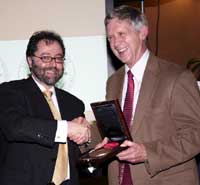 |
|
Dr. Paul Wilbur receives the Medal of Outstanding Achievement in Electric Propulsion from the Electric Propulsion Society
|
When ion propulsion propels the first spacecraft to Jupiter or delivers supplies for people going to Mars, CSU Professor Paul Wilbur and students will have a reason to celebrate. Instrumental in proving that this technology was the best means to propel spacecraft to distant planets, Wilbur, his space program and the vision he has passed on to innumerable students will have made it possible. Through four decades of research and the countless lives he has touched along the way, Dr. Paul Wilbur has impacted the field of ion propulsion and space exploration as a phenomenal researcher and world-class educator. Wilbur was recently recognized for his lifetime achievements with one of the most prestigious awards in this field, the "Medal of Outstanding Achievement in Electric Propulsion."
One of only a few recipients worldwide, Dr. Wilbur was honored by the Electric Propulsion Society at the International Electric Propulsion Conference Gala Dinner held this September in Florence, Italy for his seminal work, his many classic contributions to ion propulsion, and his invaluable role in electric propulsion education. Edgar Choueiri, president of the Electric Rocket Propulsion Society, presented the award to Dr. Wilbur and two other individuals this fall. Only eight researchers have received this honor since its inception in 2005. Dr. Robert Jahn, professor of aerospace and mechanical sciences at Princeton University and Wilbur's graduate adviser, received one of the original five awards. Wilbur is the first student of Jahn's to also be honored with this lifetime achievement medal.
Ion propulsion, a fuel efficient and low thrust form of spacecraft propulsion, utilizes accelerated ions produced from xenon gas to increase the speed of a spacecraft. After being accelerated through sets of hole pairs in two closely spaced metal plates, xenon ions escape into space at very high exhaust velocities thereby imposing a force on the spacecraft, and thus propelling it toward its destination.
Dr. Wilbur began his career in ion propulsion during a time of revolutionary discovery and innovation in space exploration. Inspired by Jahn, Wilbur earned a Ph.D. from Princeton University before joining the faculty at Colorado State University in 1968. A fantastic mentor, Jahn instilled in Wilbur a vision, based on work of Goddard and other visionaries from a century before, of expanding space flight to the outer planets — only a dream of NASA and international space agencies at the time. Although one of only a handful of scientists involved in electric propulsion in the early days, Wilbur has taken this vision and turned it into practical application through the educational and research enterprise he created at CSU.
"In our lab at CSU, we are doing the basic research to try to understand how electric propulsion works. Anyone can build a system, but to make them better you need to understand the processes that are going on and be able to model them," said Wilbur. "Rather than physically building system after system to test, we are using computer models to determine how to improve them. I think that has been our contribution — helping people make better thrusters and ultimately helping enable the acceptance of this technology. People are beginning to understand it isn't magic."
Today, deep space flight is becoming a reality, thanks to the diligence of researchers like Wilbur, and the high-caliber students he is producing. Deep Space 1, the first use of an ion thruster for primary spacecraft propulsion, was Wilbur and ion propulsion's first great success, accumulating more than 16,000 hours of thrusting. The longest firing time of any thruster in space, the Solar Electric Propulsion Technology Application Readiness (NSTAR) ion thruster propelled a satellite to the comet Borelly and past the asteroid Braille.
"Soon after I became involved in ion propulsion, NASA had the first launch into orbit of an ion thruster. We contributed to the physical understating of the processes that were occurring in these early ion propulsion devices," said Wilbur. "It is because of the students involved in our program that we have done so well."
Evidence of Wilbur's impact on the field of ion propulsion isn't just the success of Deep Space 1 and subsequent missions, but the multitude of his students who have gone on as exceptional leaders in this field and in fields related to ion source technology.
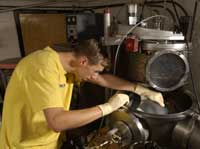 |
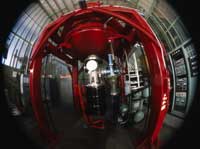 |
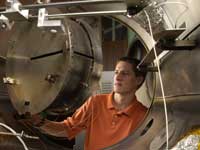 |
"Confidence in the success of the ion thruster and, thus, the Deep Space 1 mission was greatly enhanced, if not made possible by the work of Paul Wilbur," said Vince Rawlin, Deep Space 1's test coordinator at NASA. "In addition to enriching the understanding of the many physical processes in ion thrusters, Professor Wilbur motivated the students in his classrooms to assist him in the laboratory. Most of them have gone on to enjoy distinguished careers in fields related to electric propulsion with NASA, to other government agencies, industry and academia. Year after year during my visits to CSU as the Grant Monitor, I witnessed the strong bond between Paul and his students. The relationships were more like family than those of student-teacher."
"He is down-to-earth, he knows you have interests outside of school, and he gets to know you as a person," said Casey Farnell, a mechanical engineering graduate student working under Wilbur. "He can relate to students; he asks about research and sports. He is interested in getting to know his students both personally and academically."
In conjunction with previous graduate students turned distinguished scientists -- Dr. John Williams, assistant professor of mechanical engineering at CSU and Dr. John Brophy, a project element manager for NASA's Jet Propulsion Laboratory (JPL) -- Wilbur and CSU students have worked on technology currently being used by JPL to propel a rocket ship deep into space, to the largest protoplanets - Ceres and Vesta - in the asteroid belt between Mars and Jupiter. Brophy, credited by NASA for helping build confidence in the success of the ion thruster in the Deep Space 1 mission in 1998, is leading the Ion Propulsion System for the Dawn mission. Additional ion propulsion research at CSU includes novel membrane thruster, Hall thruster diagnostic technology, thruster erosion characterization, and the development of advanced power processor systems.
Ion propulsion technology and spin-offs into ion source technology, and their range of benefits to humanity are growing far beyond what early developers have anticipated. Ion engine systems, weighing significantly less and requiring less propellant mass than chemical propulsion systems, can generate greater velocity changes than combustion engines currently used in the field of space exploration. Such significant mass savings equates to smaller, less costly launch vehicles, and the capability of satellites to house more equipment. Currently, hundreds of ion thrusters and related electric propulsion devices are installed on satellites that are orbiting Earth today. Many geosynchronous satellites, kept on course by electric propulsion, are used to relay remote cell phone calls and are handling communication activities from credit card transactions to high definition television broadcasts.
Although he credits his students for the success of his program, and the research that has come out of it, Wilbur has been influential throughout the College of Engineering and University community.
"One great legacy of Paul Wilbur is his ability to give, whether it be advice, motivation, knowledge, or perspective," says Professor John Williams who has been tasked with carrying on the CSU tradition of excellence in advanced propulsion research. "I don't know how I'm ever going to continue Paul's legacy, but I can't imagine a more enjoyable or fulfilling task to work on."
In addition to the Abell Faculty Research and Graduate Program Support Award, Dr. Wilbur is recipient of numerous honors including the Oliver Pennock Award for Distinguished Service and the Engineering Dean's Council Award. He has authored or co-authored 271 publications, and has served on several American Institute of Aeronautics and Astronautics committees, and as associate editor for the Journal of Spacecraft and Rockets and the Journal of Propulsion and Power . He also serves as the CSU representative to the Colorado Space Grant Consortium.
Having trained many of the engineers working for NASA in the area of ion propulsion, and touched the lives of countless others, Professor Paul Wilbur will leave an insurmountable legacy behind at CSU as he transitions to retirement. The program he has built, and the students' lives he has touched along the way, will no doubt lead to new technology in the field of ion propulsion far into the future.
"CSU has been a great place to work. I have had great associations with the faculty here, and people have supported what I wanted to do," recounts Wilbur. "And the students have all been great."
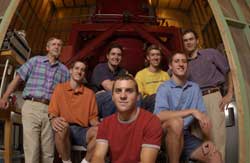 |
|
Dr. Paul Wilbur with Assistant Professor Dr. John Williams and students
|
Click here to return to the original article.
For more information on ion propulsion please visit http://www.engr.colostate.edu/ionstand/index.php